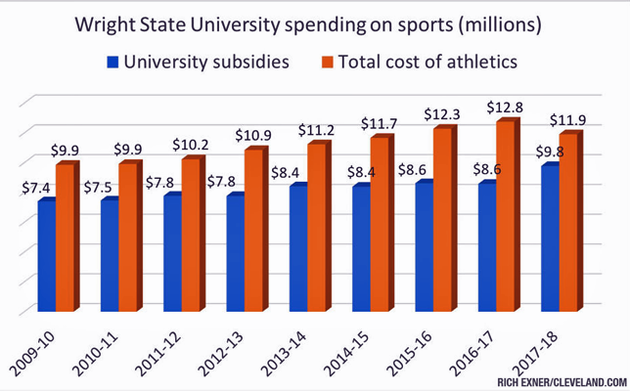
Excerpt from Cleveland.com
With the lone exception of Ohio State, part of the cost of attending Ohio’s major public universities is covering the bill for sports.
Last year, the subsidy totaled $186 million for the 10 schools that don’t raise enough money to pay for athletics through ticket sales, TV contracts, donations earmarked for sports and other sources within the athletic departments.
Often, the subsidy is in the form of mandatory student fees charged to anyone enrolling in classes. In other cases, school money or other non-athletic university resources are used for athletics.
Add it all together and the average cost to field Division I sports programs at these 10 public universities amounts to close to $1,000 a year per student on campus, regardless of whether they play sports, cleveland.com found in analyzing financial reports the schools filed with the NCAA.
Cost per student
The subsidy during the 2017-2018 school year was as high as $1,359 a student on average at cash-strapped University of Akron, and as low as $717 at Wright State.
Elsewhere in Northeast Ohio, the subsidy averaged $769 per student at Kent State, $845 at Cleveland State and $1,028 at Youngstown State. This was calculated by cleveland.com using the total athletic subsidies and the number of full-time equivalent students (two half-time students count as one).
Ohio State University, with its 100,000-plus-seat football stadium and huge TV deals through the Big Ten, is the only Ohio school able to pay its sports bill solely with money from sports.
For the other 10 schools combined, 62 percent of the $302 million spent on sports was paid for by student fees or other university non-athletic sources, cleveland.com found.
Questioning the investment
Such spending is “totally irresponsible” in the context of budget restraint on academics, said John McNay, a professor of history at the University of Cincinnati and president of the Ohio Conference of American Association of University Professors.
“Perhaps the governor or the legislature should act,” McNay told cleveland.com by email. “The legislators are always talking about the need to enhance accessibility and affordability at our public institutions and here is a case of our universities working in exactly the opposite direction.”
“Too often, state agencies have focused on tinkering with the classroom but that is not where the financial problem is. Administrative bloat, grandiose construction projects, and athletic departments that are financial blackholes, those are the areas where the problems lie.”
Justifying the investment
Investments in sports are defended on several fronts, including the marketing value for the schools and enhancement of student life in and outside the classroom.
“We believe that we provide many benefits to the institution, including national/regional media exposure that enhances the brand of the university and in turn positively impacts student enrollment, alumni relations, institutional fundraising, school pride and community relations,” Ohio University athletic spokesman Mike Ashcraft said in an email.
Among Ohio’s six Mid-American Conference schools, the subsidy provided by Ohio University to its athletic program is the lowest share, covering 55 percent of the total bill. On the high end among these schools is Akron at 70 percent.

